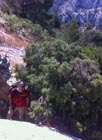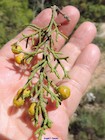
Tree in habitat on Mont de la Sainte-Victoire near Marseille, France [Réjean Drouin, 2013.09].

Tree in habitat, Marseille Veyre trail (Calanques), France [Franck Miguel, 2017.07].

Ripe cones on a shrub in habitat, Zuera, Aragón, Spain: iNaturalist observation 36973741 [javisahun, 2019.12.24]

A shrub in habitat, Zuera, Aragón, Spain: iNaturalist observation 36973741 [javisahun, 2019.12.24]

Maturing cones from a tree in habitat, Guadalajara, Spain: iNaturalist observation 45611781 [Ángel Fernández Cancio, 2016.06.02]

Cultivated seedling [C.J. Earle, 2010.06.11].

Juniperus phoenicea
Linnaeus 1753, p. 1040
Common names
Phoenician juniper (Vidakovic 1991), genévrier Phénicie (French).
Taxonomic notes
Formerly two subspecies were recognized, but one is now generally recognized as J. turbinata; since that taxon has a distinctive distribution and ecology, this has prompted a re-evaluation of J. phoenicea, and much of the published literature up to about 2015 should be taken in reference to J. turbinata. The most detailed molecular studies done to date (summarized in Juniperus) show the two species to be sisters in a highly distinctive clade within Section Sabina, not particularly closely related to any other junipers. Mazur et al. (2016) estimate that the two species diverged within the last two million years, while Mao et al. (2010) estimate the phoenicia-turbinata clade to be more than 30 million years old.
Synonymy (Farjon 1998):
- Juniperus tetragona Moench 1794
- Juniperus terminalis Salisb. 1796
- Sabina phoenicia (L.) Antoine 1857
- Sabinella phoenicia (L.) Nakai 1938
- Juniperus phoenicia (L.) subsp. eumediterreanea P. Lebreton et S. Thivend 1981
- Juniperus lycia L. 1753
- Sabina lycia (L.) Antoine 1857
- Juniperus phoenicia L. var. lobelii Guss. 1826
- Juniperus oophora Kunze 1846
- Juniperus phoenicia L. var. malacocarpa Endl. 1847
- Juniperus phoenicia L. var. sclerocarpa Endl. 1847
- Juniperus bacciformis Carr. 1855
- Sabina bacciformis (Carr.) Antoine 1857
Description
Monoecious or dioecious evergreen shrubs, or trees to 8 m tall. Bark on older trees brown, exfoliating in strips. Twigs 1 mm diameter, round, scaly. Leaves both whip and scale-like. Whip leaves on juvenile plants, 5-14 × 0.5-1 mm, acute, mucronate, with two stomatal bands on both adaxial and abaxial surfaces. Scale leaves on adult plants 0.7-1 mm long, ovate-rhombic, closely appressed, obtuse to somewhat acute, with an oblong furrowed gland and a scarious border. Seed cones 5-9 mm diameter, ripening in the 2nd year, globose to ovoid, changing from blackish to green or yellowish, sometimes slightly pruinose; dark red at maturity. Seeds (3-)7-9(-13) per cone. 2n=22. Pollen shed February-March (Adams 2014). See García Esteban et al. (2004) for a detailed characterization of the wood anatomy.
Compared to J. turbinata, the leaves are wider and more obtuse, and the seed cones a bit smaller, mostly 7-13 mm diameter (Farjon 2010). J. phoenicea cones average 8 seeds, while J. turbinata averages 5-6 seeds (Mazur et al. 2003). Also, even in sympatric populations, J. turbinata sheds pollen in October-November while J. phoenicea does so in February-March (Arista et al. 1997); see Mazur et al. (2016) for detailed discussion of morphological differences and their statistical significance. All in all, it is quite difficult to distinguish the two species unless you see them in flower or have a number of ripe seed cones to measure.
Distribution and Ecology
Andorra, France, Italy: west Liguria and in Tuscany on the Apuane Alps, and Spain; the IUCN provides a distribution map. Generally found at elevations of 0-1200 m in mountainous areas, in areas with average annual precipitation of more than 600 mm, on soils derived from dolomite (Adams 2014, Mazur et al. 2016). Zone 9 (cold hardiness limit between -6.6°C and -1.1°C) (Bannister and Neuner 2001).
The "least concern" conservation status reflects a large area of occupancy, within which this tree is often common; there is no evidence of ongoing decline, and it is present in many protected areas (Allen 2017).
Remarkable Specimens
No data as of 2023.02.21.
Ethnobotany
No data as of 2023.02.21.
Observations
No data as of 2023.02.21.
Remarks
The epithet is a misnomer; it refers to the ancient seafaring nation of Phoenicea and is a good metaphor for the distribution of J. turbinata, found on shorelines all around the Mediterranean. The type specimen, however, is from the northwest Mediterranean, over 2,500 km from Phoenicea.
J. phoenicea and J. turbinata are a good example of something we've seen a lot of since molecular taxonomy became popular: two species that seldom or never hybridize, but that have almost identical morphology. There are minor morphology differences if you know what to look for, but they are very subtle, certainly not sufficient to draw a line between different species. However, they are very dissimilar in their ecology, and they have a means of reproductive isolation - flowering at different times of the year - that facilitates evolution into differing ecological roles. If you encounter these taxa in the field, they will generally be easy to distinguish; if you're in Spain or France, in the mountains, in an area with over 600 mm of rainfall per year, you are in J. phoenicea country; if you're almost anywhere else in the Mediterranean, or near the seashore, in a hot place with less than 400 mm of rainfall per year, you're in J. turbinata country. Only in coastal southern Spain are the two species sympatric, and there morphological measurements are needed to distinguish them.
Citations
Adams, R. P. 2014. Junipers of the World, 4th ed. Trafford, Bloomington, IN. 415 p.
Allen, D.J. 2017. Juniperus phoenicea. The IUCN Red List of Threatened Species 2017: e.T16348983A99965052. https://dx.doi.org/10.2305/IUCN.UK.2017-2.RLTS.T16348983A99965052.en. Downloaded on 19 May 2020.
Arista, M., P. L. Ortiz, and S. Talavera. 1997. Reproductive isolation of two sympatric subspecies of Juniperus phoenicea (Cupressaceae) in southern Spain. Plant Systematics and Evolution 208:225–237.
Farjon, Aljos. 2010. A Handbook of the World's Conifers. Leiden, Netherlands: Brill Academic Publishers.
Linnaeus, C. 1753. Species Plantarum 2: 1040.
Mazur, M., K. Boratynska, K. Marcysiak, D. Gomez, D. Tomaszewski, J. Didukh and A. Boratynski.
2003. Morphological variability of Juniperus phoenicea (Cupressaceae) from three distant localities
on the Iberian peninsula. Act. Soc. Bot. Poloniae 72:71-78.
See also
Elwes and Henry 1906-1913 at the Biodiversity Heritage Library. This series of volumes, privately printed, provides some of the most engaging descriptions of conifers ever published. Although they only treat species cultivated in the U.K. and Ireland, and the taxonomy is a bit dated, still these accounts are thorough, treating such topics as species description, range, varieties, exceptionally old or tall specimens, remarkable trees, and cultivation. Despite being over a century old, they are generally accurate, and are illustrated with some remarkable photographs and lithographs.






